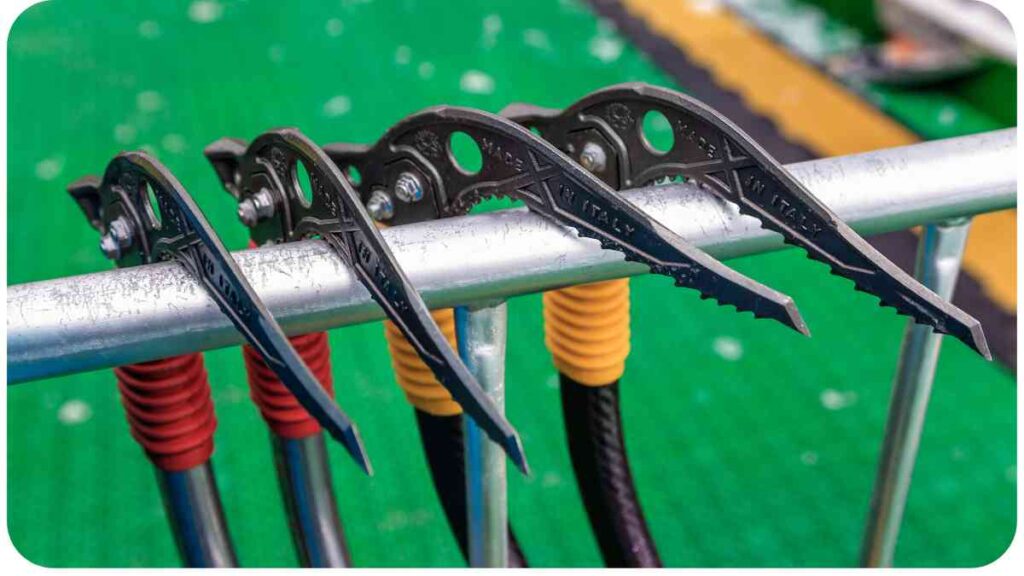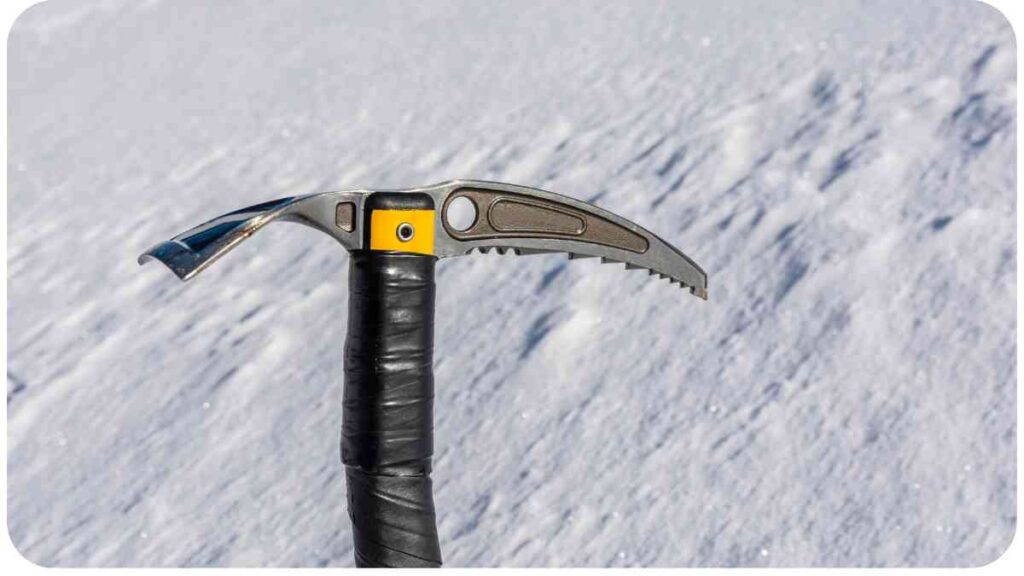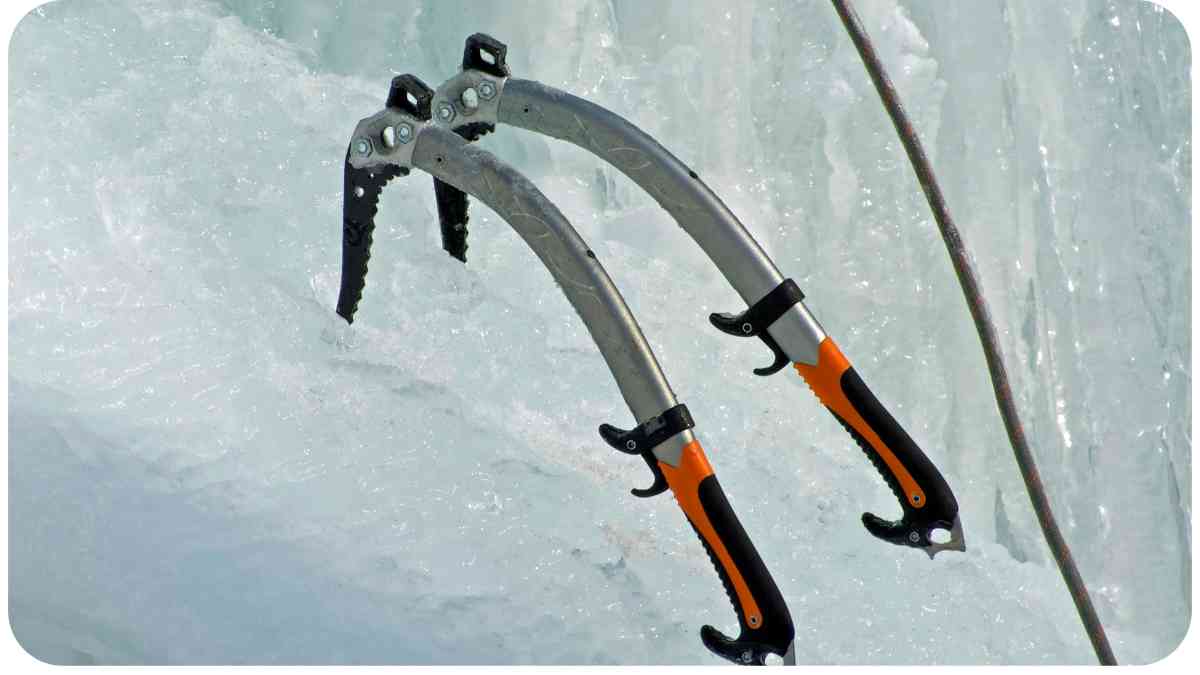Welcome to our guide on enhancing your ice axe grip! Ice climbing and mountaineering can be exhilarating and challenging activities, but the last thing you want is for your grip on your ice axe to give way.
In this article, we will explore the factors that contribute to ice axe grip slippage, discuss the importance of a secure grip, and provide you with a range of practical tips to improve your hold. Whether you’re a beginner or an experienced climber, these insights and techniques will help you conquer your icy adventures with confidence.
| Takeaway |
|---|
| Proper grip on an ice axe is crucial for safe climbing. |
| Understanding grip slippage factors helps prevent accidents. |
| Choosing the right ice axe grip enhances control and safety. |
| Techniques like the choke-up grip and finger placement aid in a secure hold. |
| Strengthening hand and forearm muscles improves grip strength. |
| Regular maintenance of the ice axe handle prolongs its grip effectiveness. |
| Safety considerations and proper training are paramount when ice climbing. |
2. Understanding the Importance of a Secure Grip
A secure grip on your ice axe is crucial for maintaining balance, stability, and control during your climb. It allows you to confidently swing and plant your ice axe, ensuring it penetrates the ice or snow efficiently.
Without a firm hold, your axe may slip, causing instability and potentially leading to accidents or falls. To prevent these situations, let’s explore the factors that can affect your grip.
Enhance your climbing prowess by learning from common speed climbing mistakes. Discover expert tips to improve your technique and conquer challenges efficiently.
3. Factors Contributing to Ice Axe Grip Slippage

Several factors can contribute to ice axe grip slippage. These include:
- Ice or snow conditions: The texture, hardness, and consistency of ice or snow can impact your grip. Different types of ice may require specific techniques and tools.
- Temperature and moisture: Cold temperatures and moisture can make the surface of your axe handle slippery. Preventing moisture buildup and using the appropriate insulation can help combat this issue.
- Glove choice: The type and fit of your gloves can affect your grip. Bulky gloves may hinder your ability to grasp the axe firmly, while thin gloves may not provide adequate insulation.
- Technique: Improper gripping techniques can reduce your ability to hold the ice axe securely. We will discuss this further in the later sections.
4. Choosing the Right Ice Axe Grip
Selecting the right ice axe grip for your climbing needs is essential. Different grips offer varying levels of comfort, control, and suitability for specific climbing styles. Here is a comparison table of common ice axe grips to help you make an informed choice:
Ensure a secure and comfortable climb by understanding harness twisting issues. Explore solutions to maintain safety and stability during your climbing adventures.
Table: Comparison of Ice Axe Grips
| Grip Type | Description |
| Basic Pommel Grip | Traditional grip with a pommel at the end. |
| Ergonomic Grip | Contoured handle designed for comfort. |
| Tapered Grip | Handle gradually tapers towards the pommel. |
| Modular Grip | Interchangeable grips for customizable use. |
| Spike Grip | Handle with a spike at the end for added grip |
Consider your personal preference, climbing style, and hand size when selecting an ice axe grip. Experimenting with different grips can help you find the one that suits you best and provides the most secure hold.
5. Tips to Improve Your Ice Axe Hold
Now that you understand the importance of a secure grip and have chosen the right ice axe grip for your needs, let’s dive into some practical tips to enhance your hold:
Table: Essential Techniques for a Stronger Grip
| Technique | Description |
| Choke-up Grip | Slide your hands closer to the head of the axe for increased control and precision. |
| Finger Placement | Position your fingers securely around the shaft, ensuring proper contact and grip strength. |
| Wrist Alignment | Keep your wrist straight to maximize leverage and prevent strain. |
| Thumbs-Under Technique | Wrap your thumbs securely around the shaft to enhance stability and prevent your grip from slipping. |
| Middle Finger Support | Utilize the strength of your middle finger to reinforce your grip. |
Mastering these fundamental techniques will significantly improve your grip and give you better command over your ice axe. Regular practice and conscious implementation of these techniques will lead to muscle memory, allowing you to execute them instinctively.
Elevate your climbing experience by mastering rope twist prevention techniques. Learn essential skills to keep your climbing rope tangle-free and ensure a smooth ascent.
6. Strengthening Your Hand and Forearm Muscles
Having strong hand and forearm muscles is vital for maintaining a solid and secure grip on your ice axe. Incorporating exercises that target these muscles into your training routine can greatly enhance your hold. Here are a few exercises to consider:
Table: Exercises to Strengthen Hand and Forearm Muscles
| Exercise | Description |
| Finger Grippers | Squeeze grippers to build finger and hand strength. |
| Wrist Curls | Perform wrist curls with a dumbbell or resistance band to strengthen forearm muscles. |
| Farmer’s Walk | Carry heavy objects, such as kettlebells or dumbbells, to improve grip strength and endurance. |
| Rock Climbing or Bouldering | Engage in these activities to work on grip strength while enjoying the sport. |
| Hand Squeezes | Use a stress ball or tennis ball and squeeze it repeatedly to strengthen hand muscles. |
By incorporating these exercises into your training regimen, you’ll gradually develop the necessary strength in your hand and forearm muscles, enabling you to maintain a secure grip on the ice axe throughout your climbs.
7. Assessing and Improving Your Technique
Apart from having the right grip and strong muscles, proper technique is crucial for a secure ice axe hold. Let’s take a look at some common mistakes climbers make with their grip and how to correct them:
Overcome grip challenges with effective solutions for peeling grip tape. Enhance your hold and maximize performance with tips tailored for climbers and alpinists.
Table: Common Ice Axe Grip Mistakes and Corrections
| Mistake | Correction |
| Gripping too tightly or too loosely | Find the balance by gripping firmly but not excessively, allowing flexibility. |
| Neglecting finger placement and control | Ensure all fingers are engaged and providing support for a solid grip. |
| Overreliance on the wrist | Utilize your entire hand and forearm to distribute the holding force. |
| Allowing the axe to rotate in the hand | Maintain consistent finger placement and use a thumbs-under technique. |
| Failing to adjust grip position when needed | Slide your hands up or down the shaft for improved control in different moves. |
By identifying these common grip mistakes and making the necessary corrections, you can significantly improve your technique and enhance your hold on the ice axe.
8. Using Grip Aids and Accessories
In addition to proper technique and grip strength, there are grip aids and accessories available to aid in maintaining a secure hold on your ice axe. Here are some popular options to consider:
Table: Popular Grip Aids and Accessories for Ice Climbing
| Grip Aid / Accessory | Description |
| Adhesive Grips | Apply adhesive grip tape or rubberized grip patches to augment the traction on the handle. |
| Thermoplastic Inserts | Customizable moldable inserts can be added to the grip, providing added comfort and tailored fit. |
| Hand Powder | Apply hand powder to reduce moisture and improve grip by absorbing sweat and moisture on your hands. |
| Handle Wraps | Neoprene or foam handle wraps can enhance grip and insulation, especially in cold and wet conditions. |
| Ice Axe Leash | A leash securely attaches your ice axe to your wrist, preventing accidental drops and allowing for secure grip changes. |
Grip aids and accessories can complement your technique and physical strength, providing additional support and comfort during your ice climbing adventures. Explore these options to find the ones that work best for you.
Achieve optimal grip by understanding chalk consistency in climbing. Explore tips to strike the perfect balance for an improved and reliable grip on the rocks.
9. Maintaining Your Ice Axe’s Grip

Ensuring the longevity and effectiveness of your ice axe’s grip is essential for a safe and reliable climbing experience. Here are some tips to help you maintain the grip of your ice axe:
- Clean and dry regularly: After each climb, wipe down your ice axe handle to remove any moisture, dirt, or debris that can accumulate and negatively impact your grip.
- Inspect for wear and tear: Check your ice axe regularly for any signs of wear, such as frayed or damaged grip materials. Replace or repair as necessary to maintain a secure grip.
- Store properly: Store your ice axe in a cool and dry place to prevent moisture buildup or exposure to extreme temperatures, which can degrade the grip material.
- Use grip protection: Consider using grip protection covers when transporting your ice axe to shield the handle from impact damage and maintain its grip quality.
By investing time and effort into maintaining the grip of your ice axe, you can ensure its reliability and prolong its lifespan, ultimately enhancing your overall climbing experience.
10. Safety Considerations
While improving your ice axe grip is important, it is equally crucial to prioritize safety during your climbs. Remember the following safety considerations:
- Proper training: Acquire proper training and knowledge from experienced climbers or certified instructors to understand the techniques, hazards, and safety protocols related to ice climbing.
- Assess weather and conditions: Before setting out on a climb, thoroughly evaluate weather conditions and ice quality to make informed decisions regarding safety and route selection.
- Use protective gear: Wear appropriate protective gear, including a helmet, harness, and crampons, to safeguard yourself in case of falls or accidents.
- Climb with a partner: Ice climbing is best done with a reliable climbing partner who can provide assistance and support in case of emergencies.
- Trust your instincts: If you feel uncertain about a particular section or grip, trust your instincts and make conservative decisions for your safety.
Remember, no climb is worth compromising your safety. Always prioritize caution, preparation, and responsible decision-making.
Conclusion
Having a secure grip on your ice axe is paramount for a successful and safe ice climbing experience. By understanding the factors influencing grip slippage, selecting the right ice axe grip, employing proper techniques, and maintaining your gear, you can significantly enhance your hold on the ice axe.
Additionally, incorporating grip aids, improving grip strength, and prioritizing safety considerations contribute to a more enjoyable and successful climb. So, take these tips on board, keep practicing, and embark on your ice climbing adventures with confidence and a rock-solid grip. Stay safe and have a thrilling ascent!
Further Reading
Here are some additional resources you can explore to learn more about using an ice axe and enhancing your grip:
- REI: How to Use an Ice Axe for Mountaineering: This comprehensive guide from REI provides detailed instructions and tips on using an ice axe for mountaineering. It covers essential techniques, self-arrest, and grip considerations.
- The Great Outdoors: Winter Skills – How to Use an Ice Axe: This article from The Great Outdoors magazine offers practical advice and step-by-step instructions on using an ice axe. It explains different grip techniques and provides insights into advanced use.
- Climb Tall Peaks: How to Use an Ice Axe: This resource from Climb Tall Peaks discusses various aspects of using an ice axe, including grip techniques, self-arrest, and different types of ice axes. It offers helpful insights and useful tips for climbers.
FAQs
Here are some frequently asked questions about ice axe grip and their answers:
What size ice axe should I choose?
The size of the ice axe depends on your height, climbing style, and intended use. Generally, for mountaineering, choose an ice axe that reaches your ankle when held in a self-arrest position.
How tight should my grip be on the ice axe?
Your grip on the ice axe should be firm but not excessively tight. It’s important to maintain some flexibility in your hand while ensuring a secure hold on the axe.
Should I wear gloves when using an ice axe?
Wearing gloves is highly recommended for both comfort and protection. Choose gloves that offer insulation, dexterity, and grip to enhance your hold on the ice axe.
Can I use a trekking pole as an ice axe?
While a trekking pole may provide some assistance, it is not a substitute for an ice axe. Ice axes are specifically designed for ice climbing and mountaineering and offer features like a pick and a proper grip for secure climbing.
How often should I replace the grip on my ice axe?
The frequency of grip replacement depends on the wear and tear of your ice axe. Inspect your grip regularly for any signs of damage or loss of traction. If you notice significant wear or a decline in grip quality, it may be time to replace the grip on your ice axe.

Welcome to my blog! I’m Hellen James, and I’m incredibly passionate about rock climbing, bouldering, ice climbing, and mountaineering. Join me as I embark on thrilling adventures, conquer vertical challenges, and share my experiences and insights with fellow outdoor enthusiasts.


